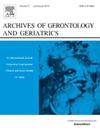Knowledge, awareness, beliefs, attitudes, current practices, and perceptions of responsibility to the identification and management of sarcopenia among Australian general practitioners and practice nurses: A national survey
IF 3.8
3区 医学
Q2 GERIATRICS & GERONTOLOGY
引用次数: 0
Abstract
Objective
To explore Australian general practitioners’ (GPs) and practice nurses’ (PNs) awareness, understanding, knowledge, beliefs, attitudes current practices, perceptions of responsibility, confidence, barriers and enablers to identification and management of sarcopenia.
Methods
A national, anonymous 33-item, online purpose-designed survey covering the topics in the aims was conducted from March-May 2024.
Results
1364 participants (97 % GPs, 62 % female) participated. Two-thirds were familiar with sarcopenia and recognised it included low muscle mass (89 %), strength (66 %) and function (53 %), but 35 % incorrectly identified low physical fitness. Knowledge on common signs/symptoms, risk factors, consequences, and treatments was generally high, but only 10–18 % recognised stiff/inflexible muscles, cramps and persistent muscle pain are not signs/symptoms, and only 9–12 % recognised any form or aerobic exercise and eating more fruits/vegetables are ineffective treatments. Most (>80 %) believed they should play an active role in sarcopenia identification/treatment, but only 23 % screened/assessed for it. Most indicated education (90 %) and screening/assessment (86 %) should be prioritized in primary care, but lack of priority (68 %), time (47 %) and confidence/knowledge (23 %) were obstacles to address sarcopenia in practice. Lack of referral options and access to appropriate tools were key barriers and protocol implementation and access to relevant training were the main enablers to identification/treatment.
Conclusion
Primary care clinicians in Australia are familiar with and have some intuitive understanding of, and positive attitudes/beliefs toward sarcopenia, recognising they should play a key role in identifying/managing it, but report it’s not a priority, they lack knowledge, confidence, referral options, appropriate tools and time to address it in practice.
澳大利亚全科医生和执业护士对肌肉减少症的识别和管理的知识、意识、信念、态度、当前实践和责任观念:一项全国性调查
目的探讨澳大利亚全科医生(gp)和执业护士(PNs)对肌少症的认识、理解、知识、信念、态度、现状、责任观念、信心、障碍和促进因素。方法从2024年3月至5月进行了一项全国性、匿名的、有33项目的在线调查,调查内容涵盖了目标中的主题。结果1364名参与者(97%为全科医生,62%为女性)参加了调查。三分之二的人熟悉肌肉减少症,并认识到它包括肌肉质量低(89%)、力量低(66%)和功能低(53%),但35%的人错误地认识到身体素质低。对常见体征/症状、风险因素、后果和治疗方法的了解程度普遍较高,但只有10 - 18%的人认为僵硬/不灵活的肌肉、痉挛和持续的肌肉疼痛不是体征/症状,只有9 - 12%的人认为任何形式的有氧运动和多吃水果/蔬菜都是无效的治疗方法。大多数人(80%)认为他们应该在肌肉减少症的识别/治疗中发挥积极作用,但只有23%的人对此进行了筛查/评估。大多数人指出,教育(90%)和筛查/评估(86%)应在初级保健中得到优先考虑,但缺乏优先考虑(68%)、时间(47%)和信心/知识(23%)是在实践中解决肌肉减少症的障碍。缺乏转诊选择和获得适当工具是主要障碍,而协议的执行和获得相关培训是识别/治疗的主要推动因素。结论澳大利亚的初级保健临床医生熟悉并对肌肉减少症有一些直观的理解和积极的态度/信念,认识到他们应该在识别/管理肌肉减少症中发挥关键作用,但报告说这不是一个优先事项,他们缺乏知识、信心、转诊选择、适当的工具和时间来解决这个问题。
本文章由计算机程序翻译,如有差异,请以英文原文为准。
求助全文
约1分钟内获得全文
求助全文
来源期刊
CiteScore
7.30
自引率
5.00%
发文量
198
审稿时长
16 days
期刊介绍:
Archives of Gerontology and Geriatrics provides a medium for the publication of papers from the fields of experimental gerontology and clinical and social geriatrics. The principal aim of the journal is to facilitate the exchange of information between specialists in these three fields of gerontological research. Experimental papers dealing with the basic mechanisms of aging at molecular, cellular, tissue or organ levels will be published.
Clinical papers will be accepted if they provide sufficiently new information or are of fundamental importance for the knowledge of human aging. Purely descriptive clinical papers will be accepted only if the results permit further interpretation. Papers dealing with anti-aging pharmacological preparations in humans are welcome. Papers on the social aspects of geriatrics will be accepted if they are of general interest regarding the epidemiology of aging and the efficiency and working methods of the social organizations for the health care of the elderly.

 求助内容:
求助内容: 应助结果提醒方式:
应助结果提醒方式:


